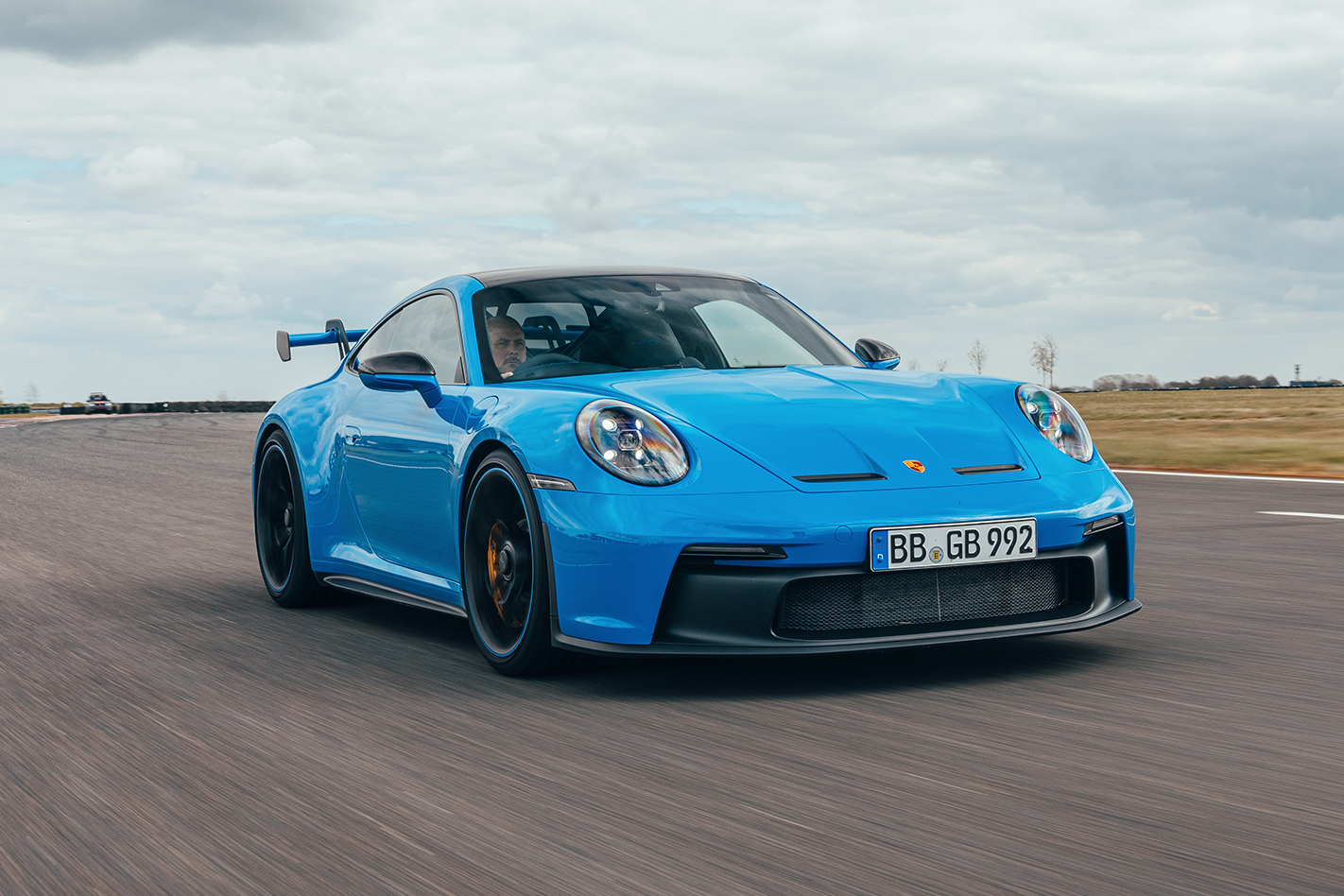The track is mine for the afternoon and the Porsche 992 GT3 is here. It’s not Bilster Berg in Germany, where the international launch event is being held, because Covid, but instead it’s Bedford Autodrome, UK.
There’s no Andreas Preuninger or Frank Walliser to download after driving here, either, but having spent time in the prototype last year between lockdowns with Preuninger, I’ve already had the lowdown from the GT boss.
The car, a RHD PDK example, arrived a couple of days ago, the track was hastily booked and I got the call to come and drive it. There was only ever going to be one answer to that request, but empty track or not, I climb into the wonderful embrace of the optional carbon fibre full bucket seats, start the engine and point the GT3’s snout towards the exit and head out on the road.
For every mile that a GT3 will do charging around a circuit, they’ll do many multiples on the road. I know it’ll be fast and capable around Bedford’s wide, fast circuit – the ludicrous sub seven-minute lap time it’s achieved around the Nurburgring underlines that – but discovering just how fast and capable it is can wait. For a bit, at least.
It’s on the road that the GT3 needs to work, because no matter how singular the GT3 is in its intent, it’s no use to anyone if it rides like a sack of spanners between track days. Expectations are high, as that previous prototype passenger ride on German country roads did suggest it’ll ride well enough, but that’s German tarmac, which is curiously smooth, in contrast to what passes for roads in the UK and Australia.
The tarmac here is ravaged by rain, frost, and occasionally, heat. Pounded by heavy goods vehicles, dug up almost daily by utility firms and having as little money spent on it as possible, the patchwork of lumpen, crumbling and meandering asphalt is as testing and nightmarish to a car’s chassis as is possible.
The GT3’s 315/30 ZR21 rear and 255/35 ZR20 front Michelins, both tyres sections being 10mm wider, might be epic around a track, but they’ve got their work cut out here.
As has the suspension the wheels and tyres hang from, the GT3’s all new front axle the single biggest change over its predecessor – and the standard Carreras and Turbos – ditching the MacPherson strut arrangement in favour of a double wishbone set-up that’s lifted almost directly from Porsche’s Cup race cars.
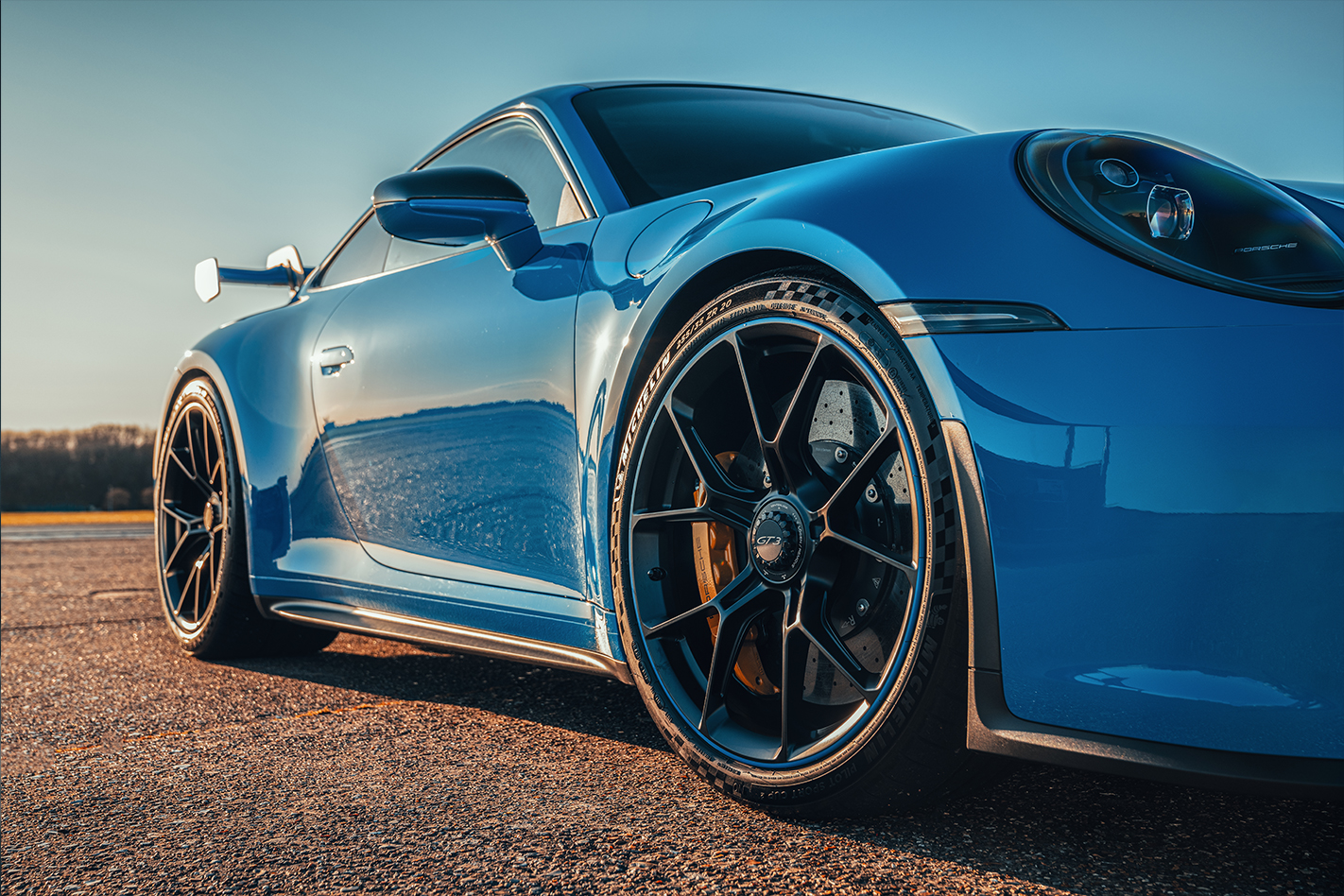
Preuninger discussed at great length the complexities of doing so during our prototype ride, not least implementing such a wholescale change into the production line process, but the benefits were deemed advantageous enough to warrant the effort.
Specifically in relation to steering precision. It’s not that you’d get out of the previous GT3 or its RS relation and bemoan sloppy responses at the front axle, but those German engineers are anything if not detail driven and they spotted the potential for improvement.
The wishbones are forged aluminium and ‘incredibly expensive’ admits Preuninger, and, in keeping with the GT boss’s dislike of any rubber in the suspension, 100 per cent rose-jointed – as are all the links at the rear. There are integrated helper springs, and the overall spring rates have more than doubled, while improved camber stability as well as less body movement in relation to roll and pitch is a result of those wishbones.
Obviously, there’s adjustment possible across the suspension’s entire spectrum, should you have a preference for how your GT3 is set up, as well as PASM (Porsche Active Suspension Management) with Sport or Track settings, selectable inside, via either the central touchscreen, or the configurable mode switch on the steering wheel.

Overall, the chassis sits some 20mm lower than that of a standard Carrera and damper response time is also significantly improved, to less than 10 milliseconds. The rear suspension is, broadly, identical to that of its 991.2 predecessor, it being a multi-link system with rear-wheel steering, with it calibrated to work with the extensive revisions to the front axle.
The standard brakes are 408mm in diameter at the front (380mm rear), the same diameter as those on the 911 Turbo, yet they’re 17 per cent lighter thanks to being narrower.
Pitted rather than through-drilled for strength, they’re internally ventilated, but the car we’re driving is fitted with optional PCCB (Porsche Ceramic Composite Brakes), which sees the front brake diameter up front grow to 410mm, and at the rear to 390mm, grabbed by six-piston monobloc fixed front, and four-piston callipers at the rear. The PCCB drops the unsprung and rotating mass by 50 per cent in comparison to a same-size cast iron disc, to the benefit of the ride.
With the previous 991.2 GT3 RS Porsche’s chassis engineers managed to retain incredible control and feel, allied to a ride that remained supple and uncompromised, and that same magic is at work here in the 992 GT3. It’s obviously taut, but the anticipated concessions to comfort when traversing the UK’s awful tarmac never materialise.

Yes, you feel the surfaces, the many ripples and undulations, but they manifest as information opposed to disruption, the steering wheel not following or being guided, the GT3’s trajectory picked by you rather than dictated by what’s rolling under its tyres.
That’s remarkable, allowing the GT3 to carry its speed easily, yet ballistic speed is just not necessary for engagement, with the GT3’s abundant feel translating to a drive that’s enjoyable even at road legal speeds. That’s most obvious in the bends, where the GT3’s steering is light and utterly predictable, that new suspension being transformative to the initial turn in, with the nose keener and more precise, holding its line with greater authority than any 911 before it, yet not so distinct from its gene pool to deny it its familial roots.
That’s a neat trick, the GT3 retaining its 911 essence, despite a front axle that’s more resolute, the engine’s rear positioning still a defining character in its make up, and appeal.
What an engine, too, the GT department’s engineering stubbornness to bow to the legislators’ demands to pass any number of sound, emissions and consumption regulations seeing all others, including Porsche itself with the turbocharged Carrera line-up, resort to smaller capacity, turbocharged or hybrid-assisted engines.
No, this 4.0-litre, naturally aspirated, 9000rpm redlined screamer’s a two-fingered salute to the bureaucratic killjoys that are strangling internal combustion engines as we charge towards the electrified era of transportation. It’s familiar, here, having been used in largely the same specification in the 991.2 Speedster, with the biggest revisions centred on the exhaust, the gasoline particulate filters to allow it to pass future regulations, but it’s putting out the same 375kW at 8400rpm and 470Nm at 6100rpm. It sounds incredible, too.
For an engine that’s so effervescent at high revs it’s hugely tractable and useable at low revs, the GT3 is fast even when you’re short shifting. Wring it out, here with the seven-speed PDK, and it’ll reach 100km/h in 3.4 seconds and 318km/h flat out, the six-speed manual is slower on the pointless benchmark sprint by 0.5 seconds, yet scaping a slight advantage in relation to top speed.
That manual is lighter, too, by a not insignificant 17kg, so if you’re after the lightest possible GT3, then manual it should be. Weight’s always a consideration with the GT3, and despite being a significantly bigger car, the GT department’s obsessive mass management allows the 992 GT3 to weigh in at 1418kg in manual form, and 1435kg as a PDK.
It’s the usual diet of lightweight carbon fibre where possible – here including the bonnet – less sound deadening, thinner glass, aluminium suspension components, no rear seats and lighter front seats. The masochists can no longer spec their GT3 sans air con and audio, because Preuninger admits allowing the one or two customers the opportunity to do so caused more headaches during development and homologation than it was worth.
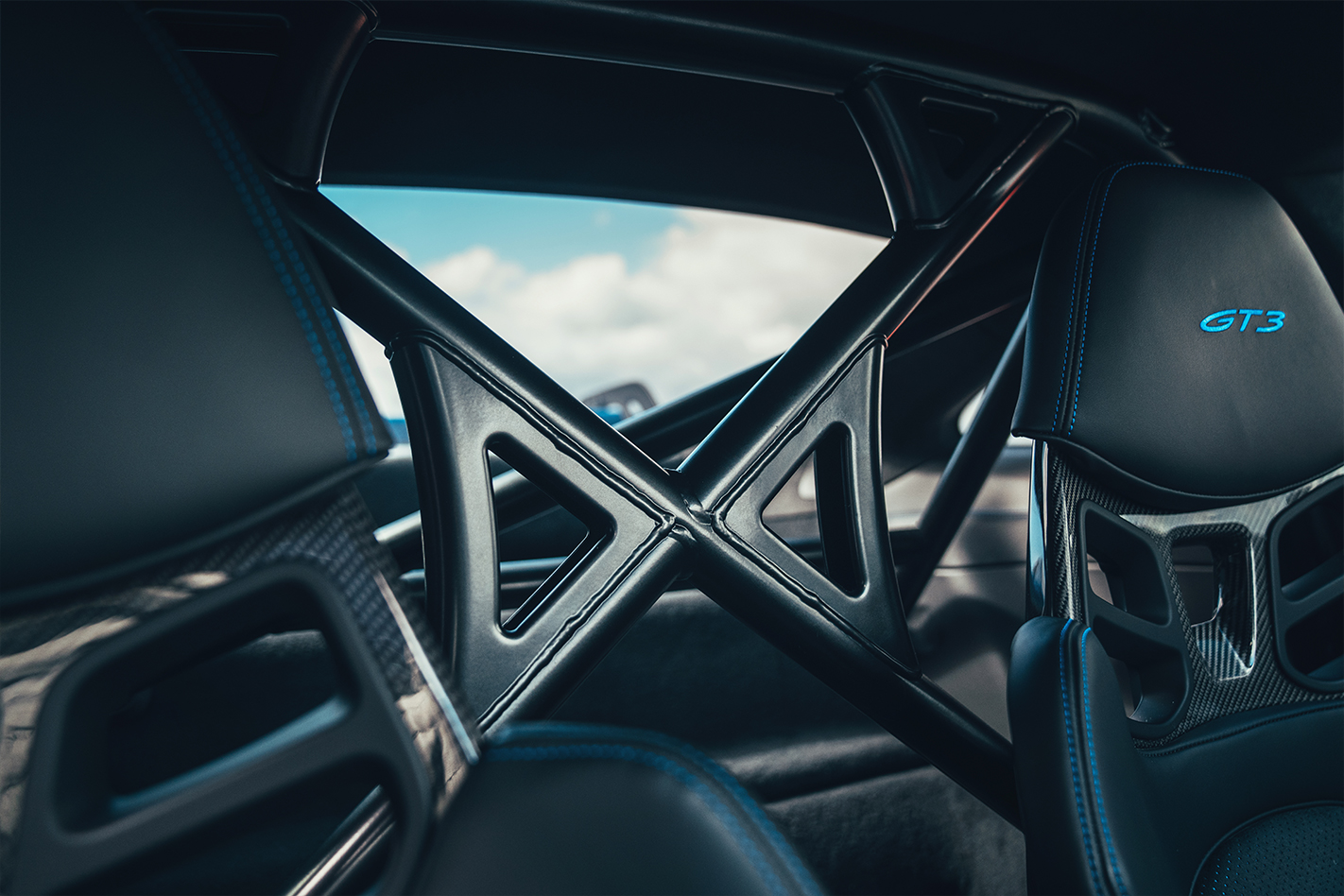
That track is calling, even if the GT3’s proved a hugely compelling and capable car on the road, there’s so much more to explore. There’s something intrinsically correct about seeing a GT3 in a pitlane. Everything starts to make more sense, the wing, swan necked here, the front splitter, the riot of intakes, vents and other aero addenda allowing this GT3 to push itself into the ground with 50 per cent more downforce than its predecessor, yet do so without creating more drag.
The interior, save the cage in the rear, doesn’t feel race-car austere, indeed, it’s familiar, comfortable even, with the instruments and specification seeing a few GT3-specific functionality gains, the most obvious being the PDK selector being a proper stick with a knob on the top, as opposed to the Carrera (and Turbo’s) almost apologetic selector.
That’s a direct result of Preuninger’s preference for shifting the PDK manually with the stick, rather than the paddles.
The multi-point harnesses that come in a box with the Clubsport specification aren’t fitted here, so it’s a regular inertia reel across that optional carbon full bucket seat that’ll be holding me in.

A couple of sighting laps at sensible speeds might usually be prudent, but, conveniently, having lapped around here only a week earlier in something else, the temptation to take it easy evaporates by the time I’m into the third corner.
In short, it’s incredible, but then that’s true of its predecessor. What’s demonstrably different is that front axle, and how transformative to the whole car it is.
It was notable on the road, but here, at far greater velocities, with the aerodynamics starting to contribute and on tarmac that’s smooth and expansive, the GT3 is so faithful to your inputs it’s like it’s directly connected to your synapses. There’s no infinitesimal pause between your input at the steering wheel and the front moving, that immediacy being the GT3’s most obvious, and biggest gain.
With the initial focus on the GT3’s front end it’s easy to ignore what’s happening at the rear, that as much a reflection of how efficiently it’s all working in unison, translating ever higher forces with impunity. The traction it’s got is staggering, allowing mind-bending, face altering G loads in cornering.

The combination of both allows ever faster cornering speed, the GT3’s ability to translate what you want it to do being so unwavering it’s difficult to comprehend that it’s running on road tyres rather than race-spec slicks.
The forces it generates are phenomenal, the speeds huge, yet doing so feels so natural, dare I say it, easy, that you find yourself eking out ever more speed on the entry, through and out the exit of a bend. The body control is sensational, there’s virtually no pitch or roll. It’s flat, yet it’ll ride up over a rippled concrete kerb on apex or on exit without it being thrown around, the suspension’s ability to manage the forces acting on it being genuinely mesmerising.
The drive modes are set to Track, both the chassis and powertrain, the PDK shifting as quickly as you can pull at the paddles the whole package feeling better and better however much more you ask from it. The PCCB brakes can be absolutely stamped on, repeatedly, to the point where you initially find you’re braking far too early, having to go deeper before committing to the brake pedal on the next lap.
There’s an incredible efficiency to how it works, it flatters, it’s biddable and responsive, yet, for all the huge speed it can generate, it’s never frightening or unpredictable. If that sounds like it might be clinical, a bit detached or aloof, it just isn’t, it’s the perfect tool around a circuit, that allows you to use it entirely how you want it to.
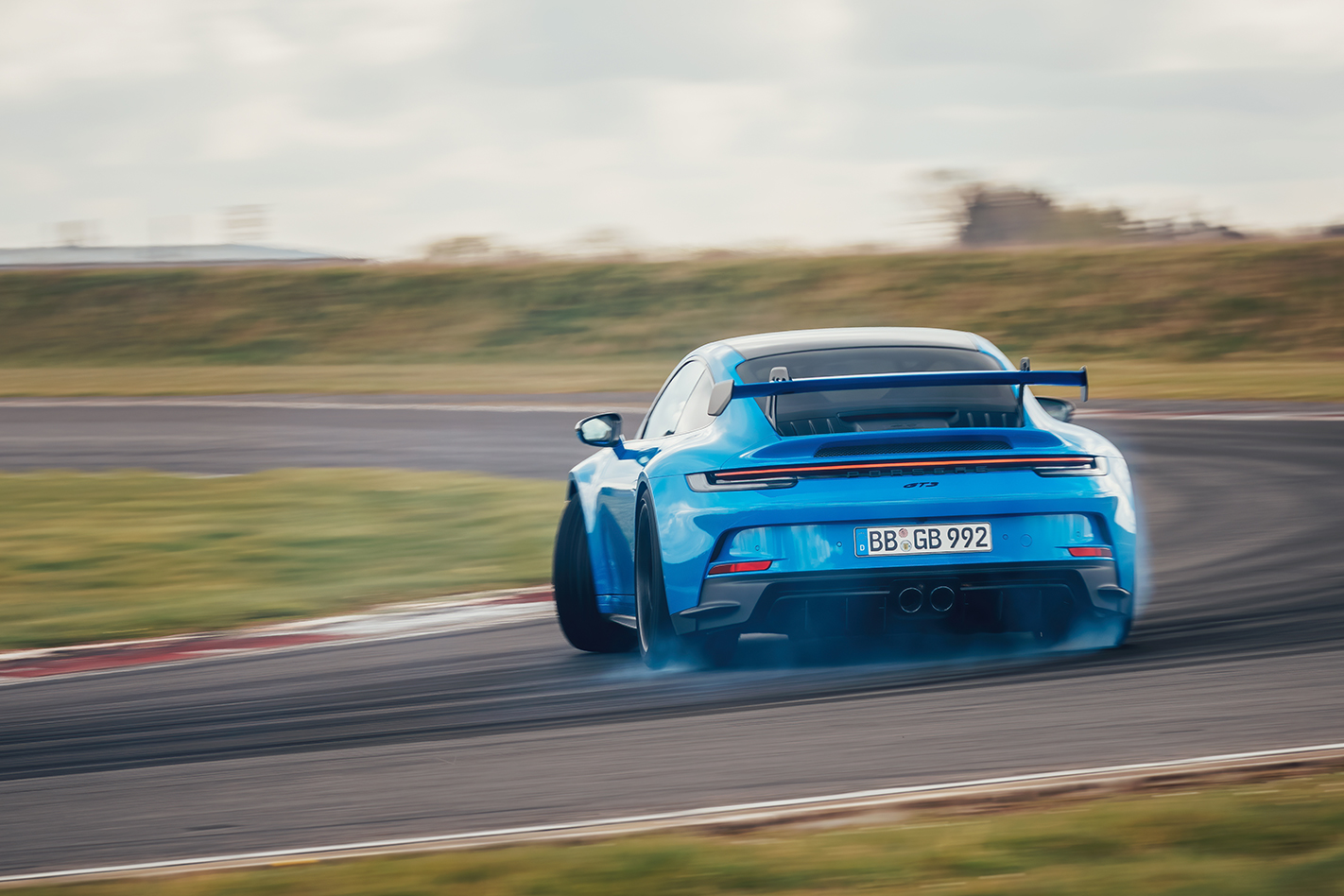
It’ll move around under you when its lofty limits are breached, but it communicates exactly what’s going on, and such is the quickness of its response to your inputs, it’s easily corrected, exploited and enjoyed. Switching the traction and ESP systems off to really delve into that only reveals even more playfulness should you want to send off a set of tyres with a smoky end.
That the focus has almost entirely been on the chassis is demonstrative. Preuninger admits that with the engine they’re pretty much at the limit of what they can do with it, hence no power increase over the Porsche Speedster.
The gains the GT3 makes are down to the platform the engine has to work with, the chassis’s greater ability, the improved aerodynamics, the maintenance of kerb weight that’s seen no real gain despite a size differential.
To ignore the engine does it a huge disservice, though, because it’s great, it is linear in its delivery, its enormous appetite for revs hugely addictive, the sound that accompanies it being music to any enthusiast’s ears.
There’s a racer’s edge to its note, especially as it reaches for its redline, the almost Italianate sounds that defined the Speedster’s exhaust, replaced here with a more Germanic tone, that’s more in keeping with the 911, it sounding so intense and delivering such pace at 6000rpm you find yourself shifting up before you need to, it needing a mental readjustment to remember that you’ve still got a third of the engine’s range to go.
Lap after lap it gets faster, braking later, carrying more speed, seeing the shift lights flicker as it reaches its redline more frequently, the GT3 just pounding out lap after lap without feeling like it’s over working its brakes, or tyres, the weak link here being the driver.
That it’s built feels like a celebration, and it should be celebrated, because it also feels like an end-of-days kind of car, the peak, internal combustion’s last stand.
Until, that is, the RS comes sometime in the next 12 months or so and blows us away all over again.
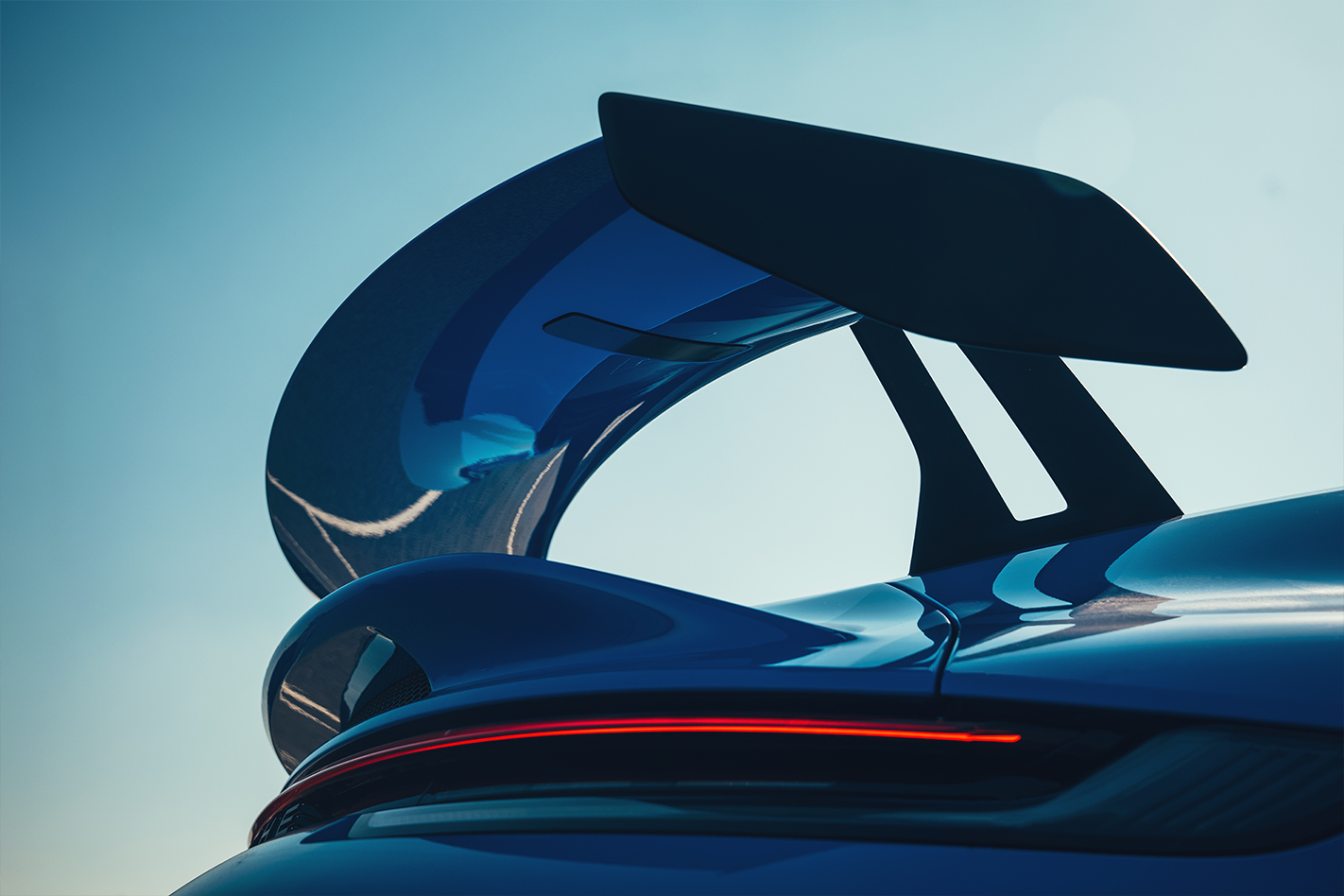
Porsche 911 992 GT3 specs
Engine: 3996cc flat-6cyl, DOHC, 24v Power: 375kW @ 8400rpm Torque: 470Nm @ 6100rpm 0-100km/h: 3.4sec (PDK) Weight: 1435kg (PDK) Price: $369,700
Like: Stronger front end; rev-hungry engine; near-perfect handling; quality of the engineering Dislike: Options pricing; try getting hold of one
Rating: 5/5

